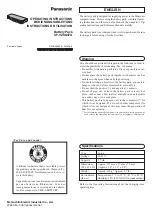
3
20.
LENGTH OF CHARGE
a.
Test the battery for state of charge. Do not charge if it is over 75% charged or the battery is determined to be defective.
b.
Set beginning amps charge rate for size of battery and state of charge per charts
c.
Charge for length of time per charge,
d.
Discontinue charge when the specific gravity of electrolyte reaches 1.260 or above. A temperature compensating hydrometer should be
used for this reading. Discontinue charge if the battery begins to gas excessively or when the temperature of the electrolyte reaches
approximately 120
°
F. Do not overcharge batteries. Overcharging results in excessive water loss and eventual damage to the battery.
ASSEMBLY INSTRUCTIONS
Remove two screws securing handle to charger. Attach the handle in an upright position.
OPERATING INSTRUCTIONS
CAUTION
- This battery charger must be fully assembled before operating. Failure to do so may result in risk of
injury.
TO CHARGE BATTERIES
Make the connections to the battery per the instructions in the previous sections. Determine if the battery is 6 or 12
volts. Set the CHARGE VOLTAGE switch to 6/12 LOW CHARGE for a 6 or 12 volt battery. If higher rate is desired, set
at 12 HIGH. DO NOT
11.8
5.9
1.110
11.9
5.95
1.140
12.1
6.05
1.185
12.4
6.2
1.225
25%
50%
75%
DEAD
Open Circuit Voltage 12V
Open Circuit Voltage 6V
Specific Gravity
STATE OF CHARGE
STATE OF CHARGE TABLE
Cold Cranking Amps
Reserve Capacity
Ampere Hours
BATTERY SIZE
60
90
350
80+
100+
400+
40
60
275
BATTERY SIZE TABLE
LARGE
MEDIUM
SMALL
BATTERY SIZE %CHARGE
0-25
25
30
40
40
20
25
30
30
35
5
5
20
25
20
30
25
20
40
10
25
40
40
30
20
40
40
15
20 15 15
10
10
15 10 10
15 30 45 60 75 90
MINUTES
A
M
P
E
R
E
S
SMALL
MEDIUM
LARGE
CHARGE RATE Vs. MINUTES CHARGE
25-50
50-75
50-75
25-50
0-25
50-75
25-50
0-25
charge a 6 volt battery at setting other than 6/12 low or charge any battery on 12V Start (Damage
may occur to the battery). Set the TIMER to the desired charge time. Length of charge should be per the above chart
and instructions. The Ammeter shows the amount of current being delivered to the battery.
12 VOLT ENGINE START
Turn off all lights and accessories in the stalled vehicle. Connect the charger to battery per previous instructions. Charge the battery on 12 HI for at
least five minutes before attempting to start the vehicle. Put the switch in the 12V ENGINE START position. Start the vehicle with the charger
connected to the battery. Follow the duty cycle on the unit.
NOTE:
DO NOT crank the engine more than 20 seconds in any five minute period; excessive cranking may overheat and damage the starter. If the
vehicle fails to start, while waiting for the starter to cool, allow the charger to continue to charge the battery. Set the CHARGE VOLTAGE switch
and TIMER to OFF and remove the AC power cord from the electric outlet before disconnecting the DC clamps.
CHARGING SULFATED BATTERIES
If your battery has sat in the discharged state for an extended period of time, it can become SULFATED. This usually is seen as a white deposit
near the top of the battery. The sulfate is formed when a battery with low water levels remains discharged for an extended time. Sulfated batteries
exhibit the characteristic of accepting no charge regardless of the rate of charge.
The charging method is two staged. The first stage of attempting to break down the sulfation to allow the battery to accept a charge must be
closely watched to avoid excessive charge rates as the battery begins to charge and overheating. The second stage is a slow charging to restore
the battery to full charge.
READ AND FOLLOW ALL PRECAUTIONS AND WARNINGS IN YOUR INSTRUCTION MANUAL BEFORE ATTEMPTING TO CHARGE
SULFATED BATTERIES. FAILURE TO OBSERVE THESE WARNINGS MAY RESULT IN PROPERTY DAMAGE OR SERIOUS PERSONAL
INJURY OR DEATH.






























